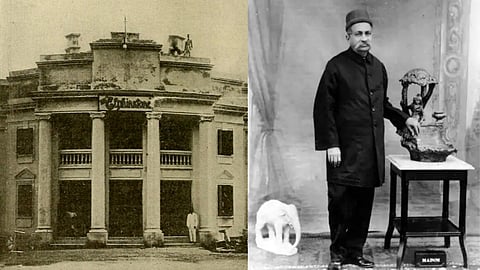
- HOMEGROWN WORLD
- #HGCREATORS
- #HGEXPLORE
- #HGVOICES
- #HGSHOP
- CAREERS
- ABOUT US
- CONTACT US

The streets of Kolkata are laden with rich cultural history and heritage. At first, Kolkata(then known as Calcutta) comprised a few scattered settlements. With the advent of the colonial powers in the 18th century, the British consolidated and developed it as the first major port city and consequently made it British India’s capital. Architecture has a special ability to bear the echoes of the past. You can tell a lot about the history of a city from its architecture. Bits and pieces of history are tucked in every nook and cranny of Kolkata. In the city of joy, you’ll find a concoction of European neoclassical, Mughal, and traditional Bengali architecture.
Kolkata today, is filled with contemporary architecture and infrastructure, which stand in juxtaposition with the colonial and post-colonial architecture, which are a symbolic reminiscence of a long-gone era. As the city grapples with a lot of modern urban infrastructural strain, modernization has trampled on the architectural legacies of not only the British but also the post-colonial common Bengali populace. Ambitious architectural modernization combined with a lack of preservation and maintenance practices has caused us to lose several old-world buildings in Calcutta.
One such old and regal building that had stood the trials and tribulations of time up until 2013 was Chaplin Cinema, the oldest single-screen movie theatre in India. It was located at 5/1 Chowringhee Place. In 1907, Jamshedji Framji Madan, an Indian theatre and film magnate and one of the pioneers of film production in India, opened its doors. Legend says that the father of arguably the greatest Bengali actor, Uttam Kumar, used to run the projector at Chaplin Cinema. Chaplin Cinema was known as Elphinstone Picture Palace when it was established. It was later renovated and came to be known as Minerva Cinema.
Minerva Cinema gained mass popularity, especially among the younger generation, who loved watching the glitz and glamour of Hollywood films. The theatre had a small, cozy, and aristocratic ambiance. Unfortunately during the 1960s, severe political violence in the streets, clashes with the youth, and rampant police vigilance resulted in the general public going back home as early as possible and not running the risk of enjoying a film in the theatre. It was disastrous for Minerva Cinema and the elegant hall physically lost its charm and grace without its patrons.
In the 1980s, after two decades of the theatre’s degradation, the local authorities took over the hall, renovated it, and renamed it ‘Chaplin’. Under strange circumstances, The Calcutta Municipal Corporation does not have any legal paperwork regarding the takeover or changing of the hall’s name. However, the fate of the hall did not overturn with its new name. It continued to suffer losses at the booking office. The authorities could not come up with any graceful solution to this problem. So, in 2013, they demolished the hall and blotted it out from Kolkata’s history.
Heritage buildings are not just a composite of bricks and cement but are symbolic of the city’s history. Unfortunately like Chaplin Cinema, several of them are in ruins and the future generation will never catch a glimpse of them, except in the pages of history. We often hear people say that Kolkata is a "city with a soul" — its vintage architecture has a lot to do with that sentiment.
If you enjoyed reading this, here's more from Homegrown:
Take A Look Inside Asia's Largest Tulip Garden
Unraveling The Legends Of Delhi's Cursed Tughlaqabad Fort
The Ties That Bind: My Trip To Pakistan Underlined How Similar Our Two Nations Really Are
